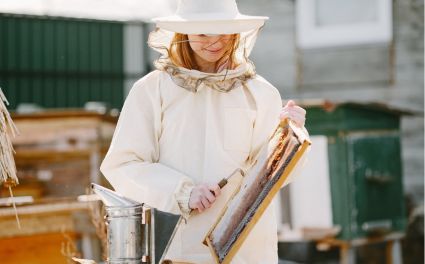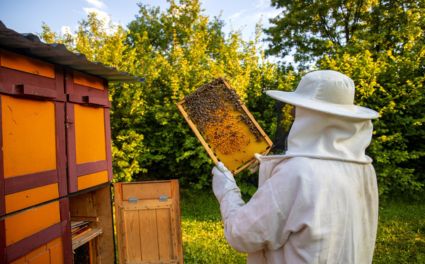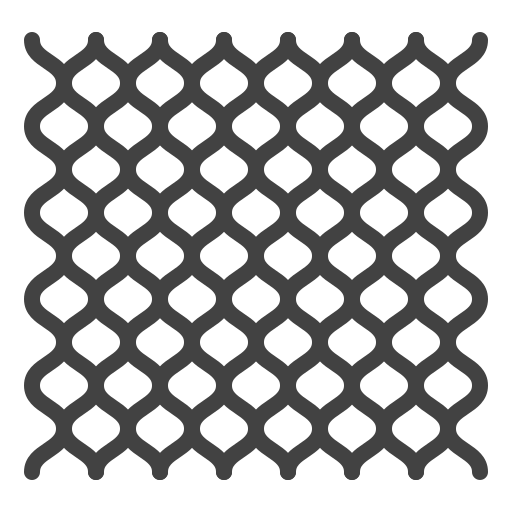Beekeeping is a fascinating and rewarding activity — but it also demands proper protective gear to ensure the beekeeper’s safety. Among all the protective clothing, beekeeping suits stand as the first and most important line of defence against bee stings and other hive-related hazards.
A beekeeper suit is not just an outfit; it’s an essential piece of safety equipment designed to create a barrier between bees and skin. Understanding what these suits are made of and how they work helps beekeepers make informed choices and stay comfortable and protected during hive inspections and honey collection.
🧥 Why Beekeeping Suits Are Essential
Beekeepers come into close contact with thousands of bees during each hive visit. Even calm colonies can become defensive if disturbed. A high-quality beekeeping suit ensures full-body protection, allowing beekeepers to work confidently without the fear of stings.
These suits act as a shield — blocking bee stingers while maintaining breathability. Combined with other protective items such as beekeeping jackets, beekeeping gloves, and beekeeping veils, they provide complete coverage from head to toe.

🧵 Outer Layer: The First Line of Defence
The outer layer of a beekeeper suit plays the most critical role — it is the layer that directly faces the bees. Traditionally, this layer is crafted from cotton or polyester, or a blend of both.
-
Cotton: A lightweight, breathable fabric that keeps the beekeeper cool during warmer months. It allows good airflow and comfort but may offer slightly less sting resistance than synthetic materials.
-
Polyester: Known for its toughness and durability, polyester provides excellent sting protection and longer lifespan but can trap more heat.
Modern beekeeping suits use a cotton-polyester blend, combining the best of both worlds — cotton’s comfort and polyester’s strength. This blend ensures the suit remains lightweight, breathable, and highly resistant to wear and tear.
Many advanced suits, like those offered by reputable brands such as OZ Armour, incorporate multi-layer ventilated mesh fabric in their designs. This unique structure creates spacing between the outer and inner layers, preventing bee stingers from reaching the skin while allowing fresh air to flow through.
🌬️ Inner Layer: Breathability and Comfort
The inner layer is all about airflow and comfort. It often features a synthetic mesh fabric, which serves multiple purposes:
-
It prevents direct contact between bees and the skin.
-
It allows ventilation, keeping the beekeeper cool during long hours of work.
-
It provides durability and flexibility for easy movement.
Common materials for the inner mesh include nylon and polyester. These are tightly woven to ensure bees cannot penetrate through, and are sometimes treated with anti-static coatings to prevent static buildup — which can irritate bees.
This combination of breathability and protection allows beekeepers to stay comfortable even during the hottest days, reducing fatigue and promoting calm, confident hive management.
🧤 Additional Components for Complete Protection
A full beekeeping outfit isn’t just about the suit itself. It includes several other components designed to protect sensitive areas.
1. Veil
The veil protects the face and neck — the most vulnerable areas. Typically made of fine mesh or netting, it ensures clear visibility and full ventilation while keeping bees away from the face.
Explore different veil styles here:
👉 Beekeeping Veils
2. Gloves
Beekeeping gloves are essential for handling frames, smokers, and hive components safely. They’re usually made from leather, canvas, or synthetic materials:
-
Leather gloves: Excellent protection and durability.
-
Canvas gloves: A balance of flexibility and strength.
-
Synthetic gloves (like nitrile): Offer better dexterity for delicate hive tasks.
Good gloves should fit snugly but still allow movement — striking the perfect balance between protection and control.
3. Trousers and Ankle Protection
While full suits are common, some beekeepers prefer beekeeping trousers paired with jackets. Elastic cuffs and zippers ensure no openings for bees to enter.
Adding beekeeping ankle protection or boots completes the lower-body shield, stopping bees from crawling upward through gaps in the pants or footwear.
4. Kids’ Beekeeping Suits
Beekeeping is increasingly becoming a family-friendly activity. Specially designed beekeeping kids suits provide young learners with the same level of protection and ventilation as adult suits, ensuring they can safely participate in hive inspections under supervision.
🧶 Suit Construction Techniques
Beyond fabric choice, construction quality determines how protective a bee suit truly is.
Reinforced Stitching
High-end suits feature double stitching and reinforced seams. This prevents bees from finding entry points and ensures long-term durability, even with regular use.
Secure Closures
Zippers, Velcro fasteners, and elastic cuffs seal every possible opening. Some premium designs overlap zippers with flaps for added protection.
Proper closures also make it easy to put the suit on and remove it quickly — essential during active hive sessions.
Adjustable Fittings
Many modern suits feature elastic waistbands, adjustable wrists, and ankles for a custom fit, ensuring the beekeeper remains comfortable and fully covered.
🧺 Maintenance and Care Tips
To keep your beekeeping suit in top condition, regular maintenance is key:
-
Clean after each use: Wash gently using mild detergent to remove bee venom, wax, or propolis. Avoid harsh chemicals or bleach.
-
Dry properly: Hang the suit in a shaded, airy spot. Prolonged direct sunlight can damage the fabric.
-
Store correctly: Use a breathable garment bag and store in a cool, dry place to prevent mould or insect damage.
-
Inspect regularly: Check seams, zippers, and mesh for tears. Repair or replace damaged parts immediately to maintain full protection.
Following these care steps ensures your protective clothing — including your beekeeping jackets, gloves, and trousers — lasts for many seasons.

🧠 How OZ Armour Excels in Beekeeping Suit Design
When discussing quality and innovation in protective beekeeping gear, OZ Armour stands out as a trusted name among professional and hobbyist beekeepers alike.
The brand focuses on combining safety, ventilation, and comfort through carefully engineered materials and design improvements. For example:
-
Multi-layer mesh suits that maximise airflow while maintaining sting protection.
-
Reinforced patches and double seams for durability.
-
Secure zippers and adjustable closures for a perfect fit.
-
Thoughtfully designed veils that offer wide visibility and protection.
Every OZ Armour suit — from their ventilated bee suits to their poly-cotton semi-ventilated options — demonstrates meticulous craftsmanship and understanding of what beekeepers need in the field.
Beekeepers across USA and beyond appreciate how OZ Armour blends protection with comfort, ensuring safety without compromising mobility or breathability.
Explore their full range of Beekeeping Suits and other protective gear to find reliable equipment tailored to your needs.
🌿 Final Thoughts
Understanding what beekeeping suits are made of helps new and experienced beekeepers make smarter choices. From the durable outer layers to the breathable mesh interiors and secure closures, every element plays a role in keeping beekeepers safe and confident.
A well-constructed suit, paired with complementary gear such as jackets, veils, gloves, trousers, and ankle protection, provides full-body safety and comfort.
For those looking to learn more about beekeeping gear, hive management, and safety techniques, visit the Beekeeping Blog to read more blogs about beekeeping and explore helpful insights shared by experts.
With thoughtfully designed protective wear from OZ Armour, beekeepers can focus on what matters most — nurturing healthy, thriving colonies with confidence and peace of mind.












